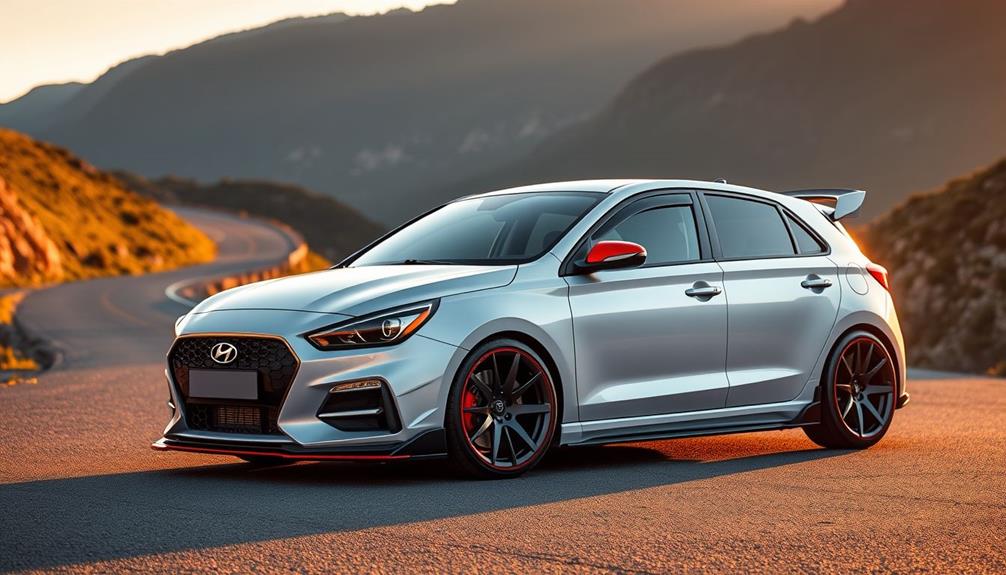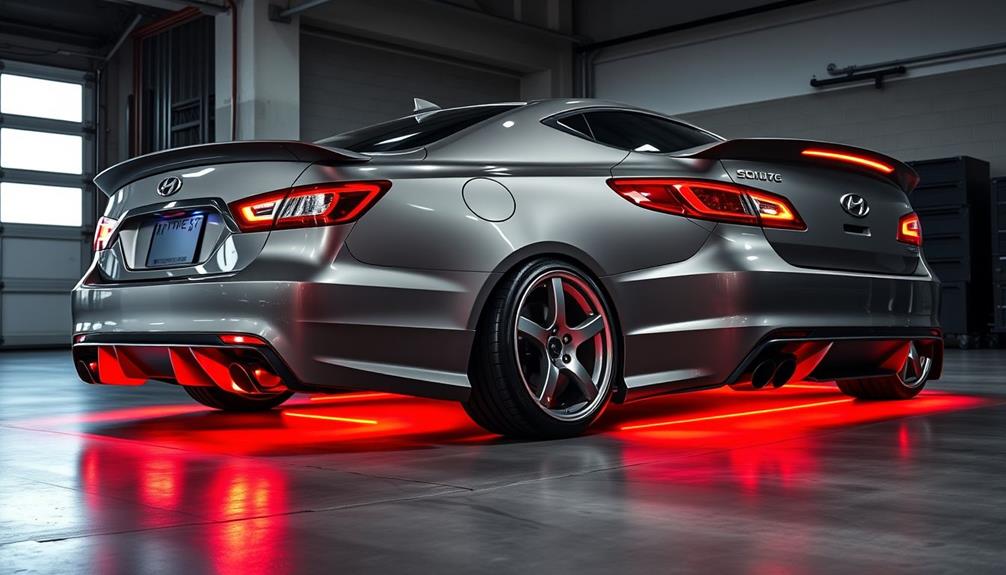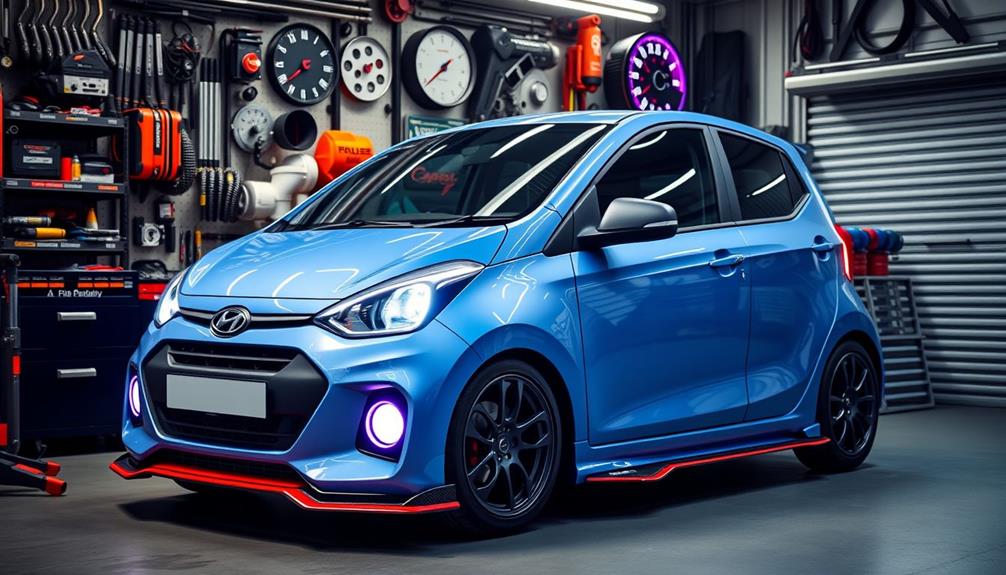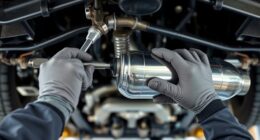To maximize your Hyundai Veloster's performance, you'll want to invest in tuning software like HP Tuners or RaceChip. These tools let you adjust key ECU parameters, boosting horsepower and improving engine responsiveness. Whether you choose a reliable service like SFR or opt for more community-driven options, make sure you understand the tuning process and use high-quality oil for engine longevity. Start with a Stage 0 tune if you've made minimal modifications, and don't forget to back up your ECU settings. You might discover even more strategies to elevate your driving experience ahead.
Key Takeaways
- Tuning software like HP Tuners allows precise adjustments to fuel maps and ignition timing for enhanced Veloster performance.
- ECU remapping is preferred over piggyback systems for reliability and engine safety during performance upgrades.
- Community feedback and research are essential for selecting reputable tuning companies for optimal results.
- Popular modifications such as turbo upgrades and aftermarket exhausts significantly boost horsepower and overall performance.
- Utilizing data logging features in tuning software helps monitor performance and make real-time adjustments.
Overview of Tuning Software
Tuning software for the Hyundai Veloster empowers you to tweak your vehicle's performance by modifying key engine control unit (ECU) parameters. With options like HP Tuners, you can easily adjust fuel maps, ignition timing, and boost levels to enhance your driving experience. Additionally, **Hyundai ECU tuning tools** allow for more precise calibration, helping to optimize your Veloster’s power output and fuel efficiency. These tools can also be used to disable certain factory limitations, giving enthusiasts the freedom to unleash the full potential of their vehicles. Whether you’re aiming for increased horsepower or improved throttle response, tuning software provides a customizable approach to performance enhancement.
This user-friendly interface allows you to engage in advanced data logging, giving you real-time insights into your vehicle's performance.
Many tuners recommend ECU remapping over piggyback systems for several reasons. Not only does ECU remapping provide better reliability, but it also guarantees the safety of your engine's integrity.
By using tuning software, you're opting for a solution that maximizes performance without compromising your vehicle's longevity.
Community-driven platforms further enrich your tuning experience, enabling you to share insights and seek advice from fellow Hyundai Veloster enthusiasts.
Regular updates and access to extensive vehicle databases in tuning software keep you informed about the latest enhancements and tuning options available for various Veloster models.
With the right tuning software, you can reveal your Hyundai Veloster's potential, guaranteeing every drive is both thrilling and efficient.
Key Tuning Companies
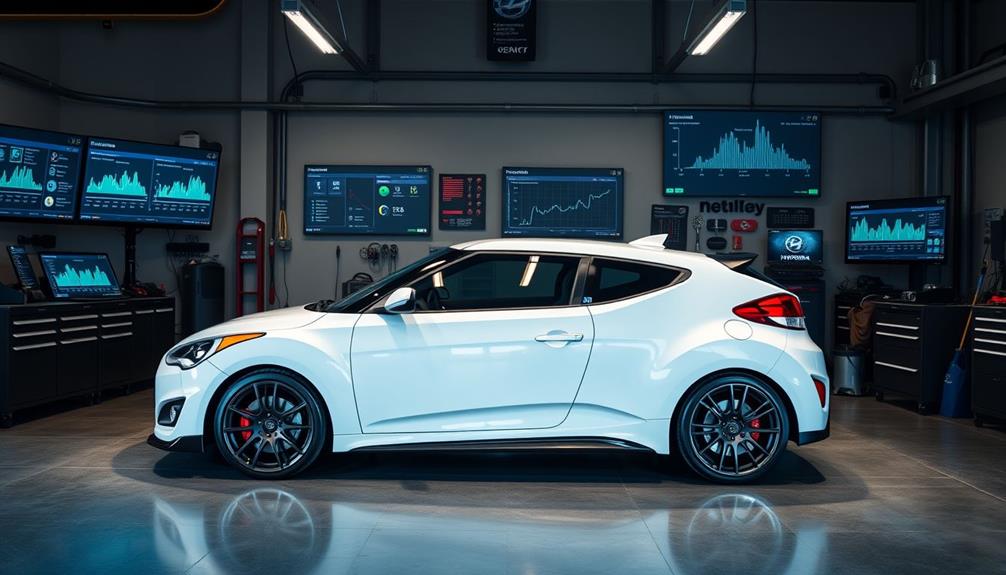
Exploring the best tuning companies for your Hyundai Veloster can greatly enhance your vehicle's performance and driving experience.
One standout option is SFR, based in Pennsylvania. They maintain close ties with Hyundai and offer reliable ECU tuning services, though you might find them a bit hard to contact.
If you're looking for a company with impressive results, check out BTRcc, which has a solid history of tuning vehicles to 500hp. Their responsive and personable service makes them a favorite among Veloster Turbo owners.
Another option is 6th Element Engineering, known for providing safe tunes through thorough research and development, although they currently offer only Stage 0 modifications.
If you want broad automotive knowledge, Eurocharged has connections to major brands, but their experience with KDM vehicles like the Veloster is somewhat limited.
Tuning Process Explained

Getting started with the tuning process for your Hyundai Veloster is straightforward and involves a few key steps. First, reach out to a tuning vendor to purchase a tune, and make certain to provide a detailed list of your vehicle's modifications. Once that's done, you'll need to ship your ECU to the vendor.
To help you navigate the tuning process, here's a quick overview:
| Step | Description |
|---|---|
| Contact Tuning Vendor | Purchase your tune and provide vehicle details |
| Ship ECU | Send your ECU along with the modification list |
| Wait for Tune | Turnaround time is usually around one week |
| Install & Remap | Follow provided instructions to complete the tune |
It's a good idea to have a spare ECU on hand to avoid any downtime while waiting for your tuned ECU to be returned. Make certain to do thorough research and check community feedback before selecting your tuning company to guarantee you're getting peak performance and reliability. This will set you up for success in enhancing your Veloster's capabilities.
Performance Considerations
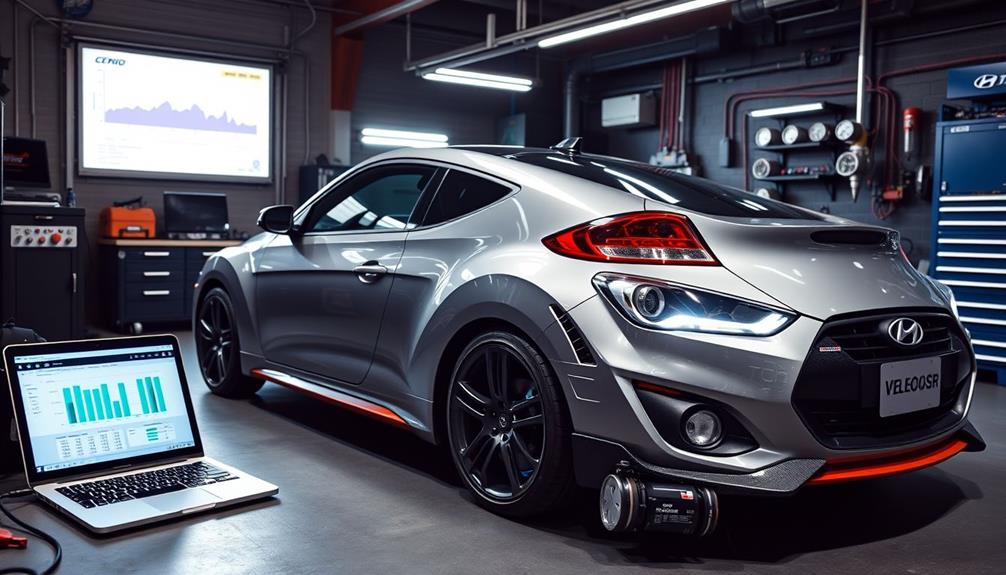
When contemplating performance for your Hyundai Veloster, it's important to focus on specific adjustments that can greatly enhance your driving experience.
Performance tuning often involves refining ignition timing and fuel mapping, which can help you make more power and improve overall horsepower and torque output. Understanding engine load maps during the tuning process allows you to tailor your strategies to meet specific performance goals.
Using high-quality oil and maintaining proper driving habits are vital for optimizing engine performance and longevity after tuning. These practices guarantee your engine runs smoothly and efficiently, especially after adjustments.
Be mindful of Low-Speed Pre-Ignition (LSPI) issues; careful tuning can mitigate these concerns, enhancing engine reliability across various driving conditions.
If your Veloster has limited modifications, a Stage 0 tune is recommended to start. As you add more extensive upgrades, you may need to take into account higher tuning stages to fully realize your car's performance potential.
Popular Modifications

Modifying your Hyundai Veloster can reveal a new level of performance and driving enjoyment. If you're looking to maximize your ride, consider these popular mods to make. Each modification enhances your driving experience, whether you own a standard Veloster or the Veloster N.
| Modification | Benefits | Estimated Power Gain |
|---|---|---|
| Turbocharger Upgrade | Boosts power output considerably | 50% or more |
| Aftermarket Exhaust | Improves airflow and reduces backpressure | Enhanced performance |
| Cold Air Intake | Increases air density for better combustion | 5-10% increase in power |
| Lightweight Wheels | Reduces weight, improving handling | Better acceleration/braking |
| Performance Brakes | Guarantees safety with increased stopping power | Essential after engine upgrades |
These modifications not only enhance performance but also add a personal touch to your Veloster. Whether you want a more aggressive sound or improved acceleration, these mods can transform your driving experience, making it more exhilarating and satisfying. Choose wisely and enjoy the improved dynamics of your Hyundai Veloster!
Community Insights and Feedback

Maneuvering the Veloster tuning community can be a game-changer for your performance upgrades. You'll find that this community places a significant emphasis on researching various tuning options. Many members share personal experiences that shape their recommendations for specific tuners, helping you make informed decisions.
User feedback consistently highlights the need to connect with knowledgeable tuners to achieve ideal performance outcomes. It's essential to balance price and performance effectively, as many community members advocate for reputable ECU tuning vendors. Typically, you can expect to spend between $300 and $400 for a quality tune, which many consider a worthwhile investment.
Discussions in forums often revolve around the reliability of piggyback tuners versus ECU tunes, with users sharing varied experiences that can help you assess what might work best for your Veloster.
Engaging with the community allows you to gather valuable insights on tuning stages and modifications, as well as the impact of fuel quality on your performance enhancements. By leveraging these community insights, you can make better choices and maximize your Veloster's potential.
Enhancing Engine Performance
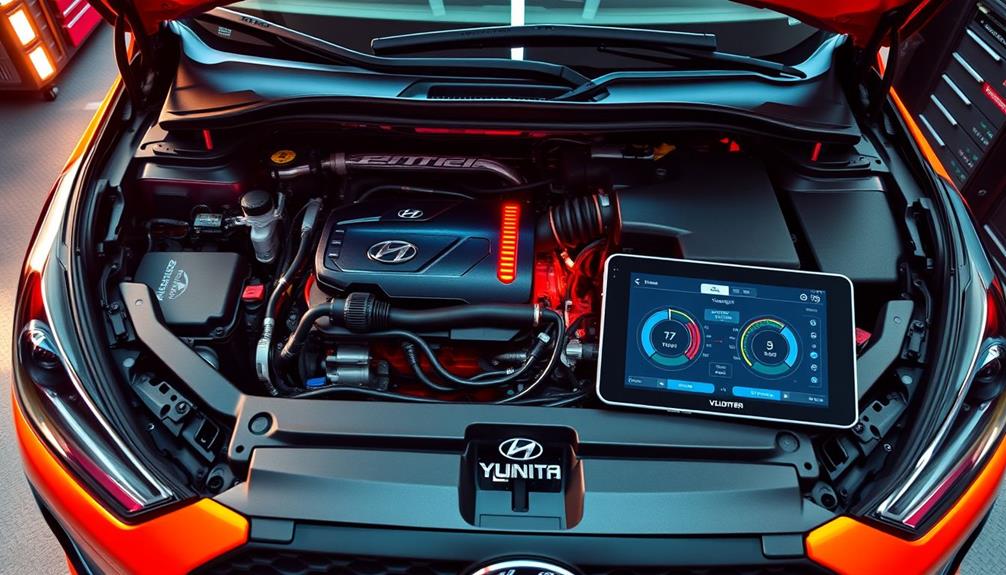
Enhancing the engine performance of your Hyundai Veloster is an exciting venture that can greatly elevate your driving experience. By using tuning software like HP Tuners or RaceChip, you can modify essential engine parameters, optimizing fuel injection and ignition timing to boost horsepower and torque.
With proper ECU remapping, you can expect a performance increase of around 10-20%, especially when paired with upgrades such as improved intakes and exhaust systems.
The RaceChip app stands out by allowing real-time tuning adjustments. You can easily switch between performance stages and monitor engine metrics directly from your smartphone, making it convenient to tailor your driving experience on the fly.
For vehicles with minimal modifications, a Stage 0 tune is ideal, while more advanced tunes require supporting upgrades to maximize performance without jeopardizing engine reliability.
Proper tuning enhances engine responsiveness and efficiency, giving you significant improvements in throttle response and acceleration.
Whether you're aiming for a specific target like achieving 270hp at the crank or just looking to enjoy a more dynamic driving experience, effective tuning software is your key to revealing your Hyundai Veloster's true potential.
Installation and Setup Tips
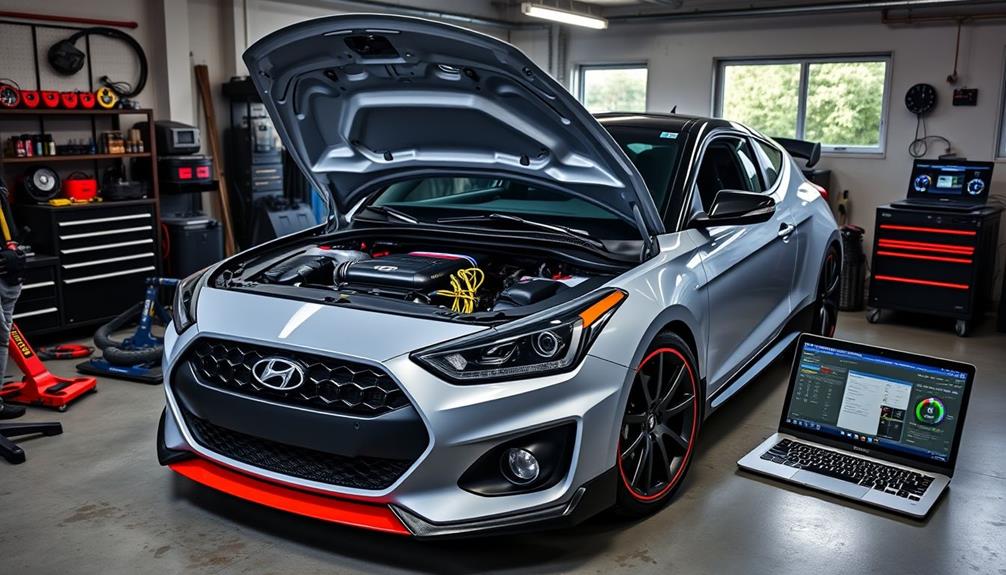
Before diving into the tuning process, it's important to confirm you have the right software for your Hyundai Veloster model, such as HP Tuners or RaceChip. Choosing compatible tuning software is significant for effectively modifying your ECU parameters.
Here are some installation and setup tips to keep in mind:
- Backup your original ECU settings: This allows you to revert changes if something goes wrong.
- Follow the manufacturer's installation instructions: Adhere to the step-by-step guidelines provided to avoid complications.
- Connect to the OBD-II port: This is necessary for integrating your software with the vehicle.
- Use a laptop or mobile device: Confirm you have the right device for a smooth installation process.
- Utilize data logging features: Monitor real-time performance to identify areas for improvement.
After installing the tuning software, take your Veloster for a thorough test drive.
Evaluate performance changes and confirm that all systems operate correctly. This step is critical to prevent potential issues down the line.
Warranty and Support Options

When you're tuning your Hyundai Veloster, understanding warranty coverage and support options is essential.
Many companies, like RaceChip, offer warranties that can protect your investment, while HP Tuners excels in providing technical support through guides and community forums.
This guarantees that you have the help you need, whether you're troubleshooting or considering reprogramming services for a new vehicle.
Warranty Coverage Details
Understanding warranty coverage for tuning software is vital as you consider performance upgrades for your Hyundai Veloster.
Different tuning packages offer varying levels of protection, so it's important to choose wisely. Here are some key points to keep in mind:
- Some products provide engine warranty options up to $10,000, depending on the tuning package.
- RaceChip products typically come with warranty periods ranging from 2 to 5 years.
- Many reputable tuning companies offer reprogramming options if you change vehicles, ensuring flexibility.
- Always read the warranty terms carefully; some tuning options may void the original manufacturer warranty if not executed properly.
- Extensive customer support often includes installation assistance and troubleshooting help.
Technical Support Availability
Choosing the right tuning software for your Hyundai Veloster doesn't just hinge on performance; it also involves the level of technical support you'll receive. When you're making modifications, knowing that you have reliable support can make all the difference.
RaceChip stands out with warranty periods ranging from 2 to 5 years, offering engine warranty options up to $10,000, depending on the product. This means you can tune with confidence, knowing you're covered.
Their extensive customer support simplifies installation and troubleshooting, ensuring you have access to help when you need it most.
HP Tuners also excels in technical support availability, boasting a detailed help section filled with user guides and documentation. This resource is invaluable for maneuvering your tuning software's features effectively.
Plus, you can tap into their community-driven environment through email and forum inquiries, fostering a space for troubleshooting and user assistance.
Regular updates for tuning software enhance functionality and vehicle compatibility, so you'll always benefit from the latest improvements.
With these support options, you can maximize your Hyundai Veloster's performance without the stress of going it alone.
Future of Veloster Tuning
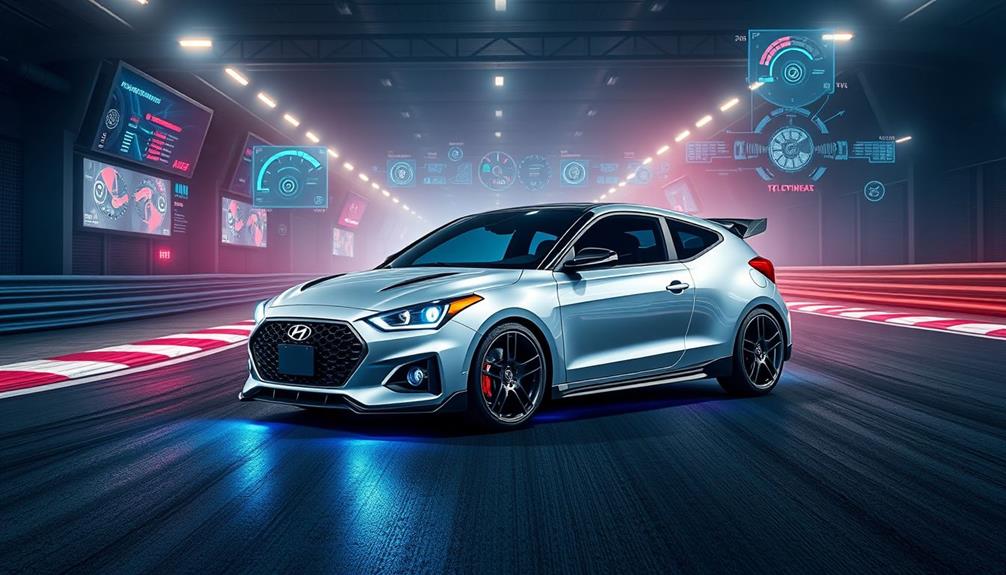
The future of Veloster tuning promises to revolutionize how enthusiasts enhance their vehicles, thanks to advancements in ECU software capabilities. With these innovations, you'll be able to achieve more precise tuning adjustments and monitor performance in real-time through advanced apps.
Here's what you can expect:
- Enhanced ECU software for tailored performance
- Collaboration between tuning companies and OEMs for reliability
- A wider range of aftermarket tuning options
- Community-driven forums to share insights and strategies
- Innovations from companies like HP Tuners and RaceChip
As the aftermarket support grows, you'll find sophisticated piggyback systems and customizable ECU maps that cater to your specific performance goals.
The rise of community-driven platforms and forums will provide an invaluable space for you to discuss your tuning experiences and gather insights from other Veloster owners. These resources will empower you to make informed decisions and refine your vehicle's performance.
Innovations in software features will set new standards for tuning flexibility, optimizing both power output and fuel efficiency.
Embrace the future of Veloster tuning, and get ready to take your performance to the next level!
Frequently Asked Questions
What Is the Speed Limiter on the Hyundai Veloster?
The speed limiter on your Hyundai Veloster is typically set around 130 mph. Depending on the model, it may vary, but you can adjust or remove it through ECU tuning, keeping safety and legality in mind.
What Is the Most Powerful Hyundai Veloster?
The most powerful Hyundai Veloster is the Veloster N. With its 2.0L turbocharged engine, it delivers up to 275 horsepower, offering thrilling acceleration and handling that'll surely enhance your driving experience on and off the track.
What Is the Top Speed of the Hyundai Veloster Turbo?
The top speed of the Hyundai Veloster Turbo is around 130 mph. With proper tuning and maintenance, you've got the potential to reach impressive speeds, especially when considering factors like weight reduction and aerodynamics.
What Are the Benefits of Hyundai Veloster?
Imagine driving a sleek, vibrant bird, soaring through the streets. The Hyundai Veloster offers you practicality, thrilling performance, and cutting-edge technology, ensuring you stay connected while enjoying a safe, agile ride wherever you go.
Conclusion
In the world of Hyundai Veloster tuning, you've got the power to reveal your ride's true potential. With the right software and modifications, you can elevate your driving experience to thrilling heights. Remember, it's not just about speed; it's about enjoying the journey and making your Veloster uniquely yours. So, gear up and embrace the adventure ahead—your car deserves a little extra love, and you'll be amazed at what it can really do!



